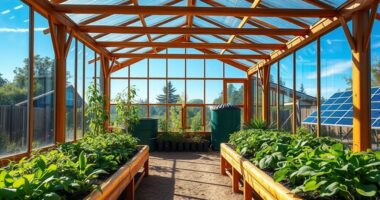To create a sustainable greenhouse for your urban garden, focus on vertical farming to maximize limited space and incorporate passive solar design by positioning the structure to catch maximum sunlight. Use insulating glazing and thermal mass to maintain temperature, and integrate solar panels for renewable energy. This combination reduces energy needs and extends your growing season. For practical tips and innovative ideas, keep exploring ways to make your urban greenhouse eco-friendly and efficient.
Key Takeaways
- Incorporate passive solar design by orienting the greenhouse south-facing in the northern hemisphere to maximize sunlight and heat collection.
- Use vertical farming techniques with shelves, wall planters, or tower gardens to optimize space and increase crop yields in limited urban areas.
- Integrate renewable energy sources like solar panels with proper orientation and maintenance to power greenhouse systems sustainably.
- Employ thermal mass elements such as water barrels or stone floors to stabilize interior temperatures and reduce energy consumption.
- Combine greenhouse design with vertical farming to extend growing seasons, enhance energy efficiency, and create a green oasis in small urban lots.

Urban gardens often face space and climate challenges, but a well-designed greenhouse can transform a small area into a thriving green oasis. One of the most effective ways to maximize limited space is through vertical farming. By growing crops upward instead of outward, you can increase your planting area without needing more ground space. Vertical farming systems utilize shelves, wall-mounted planters, or tower gardens to stack plants vertically, which is especially valuable in compact urban settings. This approach not only boosts your yield but also allows you to grow a variety of vegetables, herbs, and small fruits in a confined space. When combined with a greenhouse, vertical farming becomes even more efficient, as the controlled environment guarantees consistent growth conditions and extends your growing season.
To make the most of your greenhouse design, incorporating passive solar principles is essential. Passive solar design involves positioning your structure to maximize sunlight exposure and using materials that absorb, store, and distribute heat naturally. For example, placing the greenhouse with its longest side facing south (in the northern hemisphere) allows maximum sunlight penetration throughout the day. Using high-quality, insulating glazing minimizes heat loss during colder months while still letting in ample sunlight. You can also integrate thermal mass elements, such as water barrels or stone floors, that absorb heat during the day and release it at night, maintaining a stable temperature inside your greenhouse. This reduces your reliance on artificial heating, making your setup more sustainable and cost-effective.
Additionally, selecting the right solar panel orientation and maintenance practices can further enhance your greenhouse’s energy efficiency and sustainability. Combining vertical farming with passive solar design results in a highly efficient, eco-friendly urban greenhouse. The vertical systems can be positioned strategically to catch the sun’s rays, optimizing light distribution and ensuring your plants receive the right amount of sunlight and airflow. This synergy not only conserves space but also improves energy efficiency, as natural heat and light minimize the need for supplemental heating and lighting. Additionally, the greenhouse’s orientation and materials can help regulate temperature fluctuations, creating a stable environment that supports healthy plant growth year-round.
In essence, by leveraging vertical farming techniques and passive solar principles, you can turn even the smallest urban lot into a productive, sustainable garden. These design strategies work hand-in-hand to optimize space, reduce energy consumption, and extend your growing season, making urban gardening more accessible and environmentally conscious. With thoughtful planning, your greenhouse can become a resilient oasis, thriving amidst the constraints of city life.
Frequently Asked Questions
How Do Greenhouses Impact Urban Heat Islands?
Greenhouses help reduce urban heat islands by providing urban cooling and combating heat absorption. When you incorporate greenhouses into city landscapes, they lower surrounding temperatures through shade and evapotranspiration. Their plants absorb heat, preventing excessive heat buildup. By managing heat absorption and promoting urban cooling, greenhouses make cities more comfortable and sustainable, ultimately reducing the heat island effect and improving overall urban climate.
What Are Cost-Effective Materials for Sustainable Greenhouse Construction?
Imagine building your greenhouse with friendly, budget-savvy choices; recycled plastics serve as clear, durable panels, letting sunlight nurture your plants, while bamboo framing offers a lightweight, eco-friendly structure. These cost-effective materials blend sustainability with affordability, reducing environmental impact and construction costs. By choosing recycled plastics and bamboo, you create a greener space that’s easy on your wallet and the planet, making your urban garden both beautiful and sustainable.
How Can Greenhouses Improve Urban Air Quality?
Greenhouses can improve urban air quality by enhancing indoor air purification and promoting plant pollutant absorption. You can achieve this by selecting plants known for their air-cleaning abilities, such as spider plants or peace lilies, and ensuring proper ventilation. Regularly maintaining your greenhouse helps maximize these benefits, reducing airborne pollutants and improving overall air quality in your urban environment. This creates a healthier space for both people and plants.
What Maintenance Is Required for Eco-Friendly Greenhouse Systems?
Think of your eco-friendly greenhouse as a well-tuned vintage clock; it needs regular care. You’ll want to manage vegetation to prevent overgrowth and guarantee healthy plants. Routine pest control keeps unwanted visitors at bay, maintaining a balanced ecosystem. Check ventilation systems, water levels, and filters often. Prune plants and clean surfaces regularly, and monitor for any signs of disease. Consistent maintenance keeps your greenhouse thriving and eco-friendly.
Are There Government Incentives for Building Green Urban Greenhouses?
Yes, you can get government incentives for building green urban greenhouses. These programs often support urban agriculture initiatives that incorporate renewable energy and eco-friendly designs. By applying for grants or tax credits, you can reduce costs and promote sustainable development. Check local and national government websites to find specific incentives available in your area, and guarantee your greenhouse project aligns with their environmental and urban agriculture goals.
Conclusion
Embracing sustainable greenhouse designs in your urban garden isn’t just about saving energy or space — it’s about creating a resilient, eco-friendly haven that benefits both your community and the planet. Some might think it’s too complex or costly, but with simple, innovative approaches, you can make a lasting impact. Remember, small steps toward sustainability can inspire larger change, proving that even in a city, your garden can be a powerful force for environmental stewardship.









